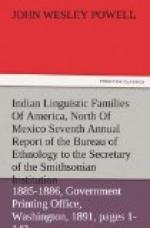The extent of the Salish or Flathead family was unknown to Gallatin, as indeed appears to have been the exact locality of the tribe of which he gives an anonymous vocabulary from the Duponceau collection. The tribe is stated to have resided upon one of the branches of the Columbia River, “which must be either the most southern branch of Clarke’s River or the most northern branch of Lewis’s River.” The former supposition was correct. As employed by Gallatin the family embraced only a single tribe, the Flathead tribe proper. The Atnah, a Salishan tribe, were considered by Gallatin to be distinct, and the name would be eligible as the family name; preference, however, is given to Salish. The few words from the Friendly Village near the sources of the Salmon River given by Gallatin in Archaeologia Americana, II, 1836, pp. 15, 306, belong under this family.
GEOGRAPHIC DISTRIBUTION.
Since Gallatin’s time, through the labors of Riggs, Hale, Tolmie, Dawson, Boas, and others, our knowledge of the territorial limits of this linguistic family has been greatly extended. The most southern outpost of the family, the Tillamook and Nestucca, were established on the coast of Oregon, about 50 miles to the south of the Columbia, where they were quite separated from their kindred to the north by the Chinookan tribes. Beginning on the north side of Shoalwater Bay, Salishan tribes held the entire northwestern part of Washington, including the whole of the Puget Sound region, except only the Macaw territory about Cape Flattery, and two insignificant spots, one near Port Townsend, the other on the Pacific coast to the south of Cape Flattery, which were occupied by Chimakuan tribes. Eastern Vancouver Island to about midway of its length was also held by Salishan tribes, while the great bulk of their territory lay on the mainland opposite and included much of the upper Columbia. On the south they were hemmed in mainly by the Shahaptian tribes. Upon the east Salishan tribes dwelt to a little beyond the Arrow Lakes and their feeder, one of the extreme north forks of the Columbia. Upon the southeast Salishan tribes extended into Montana, including the upper drainage of the Columbia. They were met here in 1804 by Lewis and Clarke. On the northeast Salish territory extended to about the fifty-third parallel. In the northwest it did not reach the Chilcat River.
Within the territory thus indicated there is considerable diversity of customs and a greater diversity of language. The language is split into a great number of dialects, many of which are doubtless mutually unintelligible.
The relationship of this family to the Wakashan is a very interesting problem. Evidences of radical affinity have been discovered by Boas and Gatschet, and the careful study of their nature and extent now being prosecuted by the former may result in the union of the two, though until recently they have been considered quite distinct.




